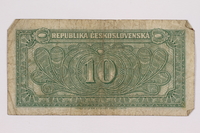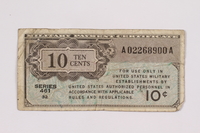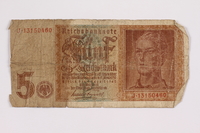Overview
- Description
- The papers consist of a scrapbook, a newspaper clipping, and a document (4 pages) collected by Dixie Foster while she served as a secretary during the war crime trials in Europe after World War II.
- Credit Line
- United States Holocaust Memorial Museum Collection, Gift of Gretchen Davenport
Physical Details
- Language
- English
- Genre/Form
- Scrapbooks. Clippings (Books, newspapers, etc.)
- Extent
-
1 oversize box
Rights & Restrictions
- Conditions on Access
- There are no known restrictions on access to this material.
- Conditions on Use
- Material(s) in this collection may be protected by copyright and/or related rights. You do not require further permission from the Museum to use this material. The user is solely responsible for making a determination as to if and how the material may be used.
Keywords & Subjects
- Topical Term
- War crime trials--Europe.
Administrative Notes
- Holder of Originals
-
United States Holocaust Memorial Museum
- Legal Status
- Permanent Collection
- Provenance
- The papers were donated to the United States Holocaust Memorial Museum in 2004 by Gretchen Davenport, the niece of Dixie Foster.
- Record last modified:
- 2023-02-24 14:21:29
- This page:
- https://collections.ushmm.org/search/catalog/irn521965
Download & Licensing
- In Copyright - Use Permitted
- Terms of Use
- This record is not digitized and cannot be downloaded online.
In-Person Research
- Request 7 Days in Advance of Visit
- Plan a Research Visit
-
Request in Shapell Center Reading Room
Bowie, MD
Contact Us
Also in Dixie Foster collection
The collection consists of currency, documents, publications, and a scrapbook relating to the experiences of Dixie Foster when she worked as a court reporter during the US Military Tribunal known as the Dachau war crimes trials, in Germany after World War II.
Date: 1939-1947

Kingdom of Italy, 2 lire note, acquired by a war crimes trials court reporter
Object
Italian 2 lire bank note acquired by Dixie Foster when she worked as a civilian court reporter during the US War Crimes Tribunal at the former Dachau concentration camp in Germany, also known as the Dachau war crimes trials. The trials were conducted in the American postwar occupation zone by the US Army from November 1945 to August 1948. The Kingdom of Italy had a Fascist government from 1922-1943, led by Benito Mussolini. It was closely allied with Nazi Germany and lost control of most of the country in 1943. Not long after the war ended on May 7, 1945, a constitutional referendum was held in June 1946 and Italy abolished the monarchy and became a republic.

Italy Ministry of the Treasury, 1 lire note, acquired by a war crimes trials court reporter
Object
Italian 1 lire bank note acquired by Dixie Foster when she worked as a civilian court reporter during the US War Crimes Tribunal at the former Dachau concentration camp in Germany, also known as the Dachau war crimes trials. The trials were conducted in the American postwar occupation zone by the US Army from November 1945 to August 1948. The Kingdom of Italy had a Fascist government from 1922-1943, led by Benito Mussolini. It was closely allied with Nazi Germany and lost control of most of the country in 1943. This currency was issued in 1944 by the provisional government established with Allied support in the non-Fascist region. Not long after the war ended on May 7, 1945, a constitutional referendum was held in June 1946 and Italy abolished the monarchy and became a republic.

Republic of Czechoslovakia, 10 korun note, acquired by a war crimes trials court reporter
Object
Czechoslovakian 10 korun bank note acquired by Dixie Foster when she worked as a civilian court reporter during the US War Crimes Tribunal at the former Dachau concentration camp in Germany, also known as the Dachau war crimes trials. The trials were conducted in the American postwar occupation zone by the US Army from November 1945 to August 1948. During World War II, Czechoslovakia ceased to exist as the country was partitioned and absorbed by Nazi Germany and its allies. In April 1945, Germany was losing the war and the Third Republic of Czechoslovakia was created. This currency was issued on November 1, 1945, by the new republic.

Republic of Czechoslovakia, 10 korun note, acquired by a war crimes trials court reporter
Object
Czechoslovakian 10 korun bank note acquired by Dixie Foster when she worked as a civilian court reporter during the US War Crimes Tribunal at the former Dachau concentration camp in Germany, also known as the Dachau war crimes trials. The trials were conducted in the American postwar occupation zone by the US Army from November 1945 to August 1948. During World War II, Czechoslovakia ceased to exist as the country was partitioned and absorbed by Nazi Germany and its allies. In April 1945, Germany was losing the war and the Third Republic of Czechoslovakia was created. This currency was issued on November 1, 1945, by the new republic.

United States Military payment certificate, 10 cent note, acquired by a war crimes trials court reporter
Object
Military payment certificate for 10 cents acquired by Dixie Foster when she worked as a civilian court reporter during the US War Crimes Tribunal at the former Dachau concentration camp in Germany, also known as the Dachau war crimes trials. The trials were conducted in the American postwar occupation zone by the US Army from November 1945 to August 1948.

Allied Military, 10 mark note, with inscription by a war crimes trials court reporter
Object
Allied military currency valued at 10 marks acquired by Dixie Foster when she worked as as a civilian court reporter during the US War Crimes Tribunal at the former Dachau concentration camp in Germany, also known as the Dachau war crimes trials. The trials were conducted in the American postwar occupation zone by the US Army from November 1945 to August 1948. It was inscribed on May 5, 1946, by Dixie and a US Colonel with whom she worked in Germany.

Republic of Czechoslovakia, 20 korun note, acquired by a war crimes trials court reporter
Object
Czechoslovakian 20 korun bank note acquired by Dixie Foster when she worked as a civilian court reporter during the US War Crimes Tribunal at the former Dachau concentration camp in Germany, also known as the Dachau war crimes trials. The trials were conducted in the American postwar occupation zone by the US Army from November 1945 to August 1948. During World War II, Czechoslovakia ceased to exist as the country was partitioned and absorbed by Nazi Germany and its allies. In April 1945, Germany was losing the war and the Third Republic of Czechoslovakia was created. This currency was issued on November 1, 1945, by the new republic.

Nazi Germany, 5 mark note, acquired by a war crimes trials court reporter
Object
German bank note valued at 5 marks, issued in 1939, acquired by Dixie Foster when she worked as a civilian court reporter during the US War Crimes Tribunal at the former Dachau concentration camp in Germany, also known as the Dachau war crimes trials. The trials were conducted in the American postwar occupation zone by the US Army from November 1945 to August 1948.

Bank of Algeria, 100 franc note, acquired by a war crimes trials court reporter
Object
French Algerian bank note valued at 100 francs acquired by Dixie Foster when she worked as a civilian court reporter during the US War Crimes Tribunal at the former Dachau concentration camp in Germany, also known as the Dachau war crimes trials. The trials were conducted in the American postwar occupation zone by the US Army from November 1945 to August 1948.
Camps de mort [Book]
Object
Illustrated history of the death camps in Europe created immediately after the end of World War II in May 1945. It was acquired by Dixie Foster when she worked as a civilian court reporter during the US War Crimes Tribunal at the former Dachau concentration camp in Germany, also known as the Dachau war crimes trials. The trials were conducted in the American postwar occupation zone by the US Army from November 1945 to August 1948.
Pamphlet
Object
Softcover book titled, Illustrated history of the Dora-Nordhausen War Crimes Trial, given to Dixie Foster with a personal inscription by the author. It was acquired by Dixie when she worked as a civilian court reporter during the US War Crimes Tribunal at the former Dachau concentration camp in Germany, also known as the Dachau war crimes trials. The trials were conducted in the American postwar occupation zone by the US Army from November 1945 to August 1948. William J. Aalmans, the author, was a War Department civilian and a member of the Netherlands Army, who was attached to a War Crimes Investigation Team of the First American Army. He edited and complied the book and also witnessed and photographed some of the scenes presented in the book.
Portfolio
Object
Portfolio of rotogravure prints of 24 drawings by George (Jerzy) Zielezinski depicting scenes he witnessed of daily life and death as a prisoner in German concentration camps from 1943-1945. The set includes a portfolio cover, a folded insert with an essay about the prints, and 24 individual reproductions. After his emigration to the US in 1949, sets were sold by the American Friends Service Committee to raise funds for Zielezinski's support. Zielezinski, a Polish Catholic, was arrested in March 1943 in Warsaw by the German occupation authorities for political activity. He was sent to Auschwitz and, in January 1944, to Flossenbürg. In mid-April 1945, as Allied troops approached, the SS began evacuations, sending prisoners to Dachau on trains and via death marches. After liberation on April 29, 1945, Jerzy was hospitalized and while recovering he made finished drawings of camp life and atrocities, based upon the sketches he made secretly on scraps of paper in the camps. He then lived in Schwandorf and Munich displaced persons camp, until gong to America. The portfolio was acquired by Dixie Foster, presumably when she worked as a civilian court reporter during the US War Crimes Tribunal at the former Dachau concentration camp in Germany, also known as the Dachau war crimes trials. The trials were conducted by the US Army in the American postwar occupation zone from November 1945 to August 1948.



